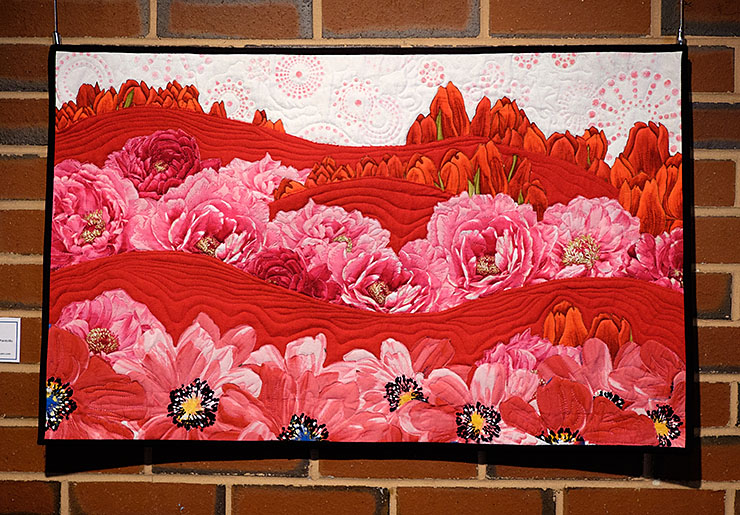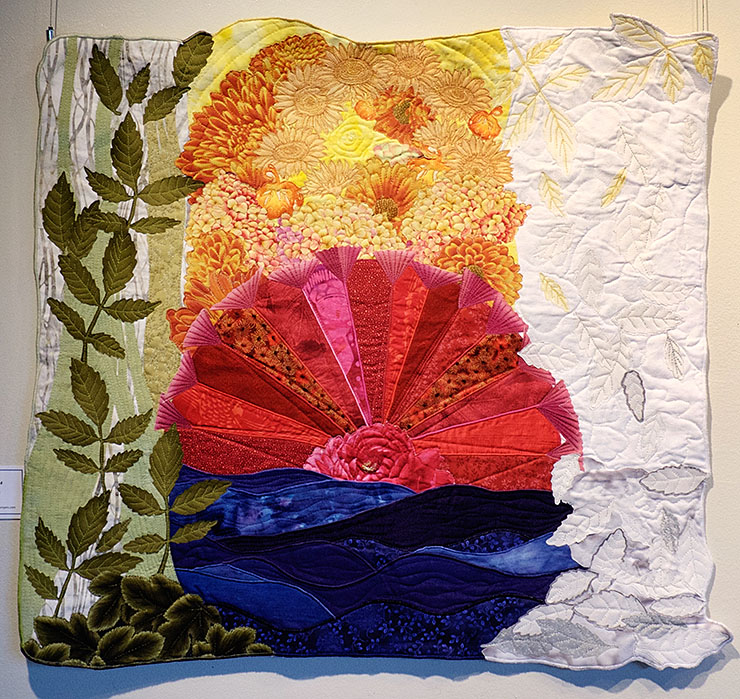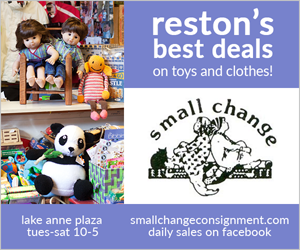During my interview with artist Anne Smyers in the Reston Community Center about her current exhibit there, she was frequently stopped by admirers of her work. “Are you the artist? Your work is extraordinary!” “There are no words, wow.” “My grandmother used to quilt, and I’d love to learn to make ones like yours.” “Your handwork is magnificent.” And best of all, “I’m sorry to interrupt, but I’d like to buy one of your quilts.”
I wasn’t at all surprised by those enthusiastic greetings. Anne Smyers’ work is striking, imaginative, colorful, and memorable. I was immediately drawn to her quilted landscapes on a recent visit to the RCC, and I contacted her to learn more about them.
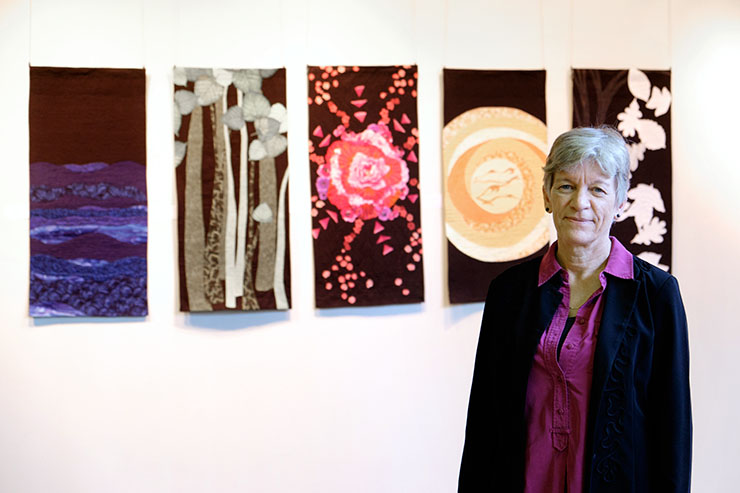
Fiber Artist Anne Smyers, with her “Five Element Study” series at the Reston Community Center at Hunters Woods
Anne Smyers refers to her quilted creations as “Floral Landscapes.” She describes them as fanciful and whimsical, and claims that they reveal a different side of her typically pragmatic personality. By day, however, Anne Smyers is an interior decorator and Tai Chi instructor, and her background in design and Eastern philosophies are evident in her artwork.
Anne lives in Reston, and has exhibited her work in shows and magazines around the country. Her work is currently displayed as the featured October exhibit at the Reston Community Center at Hunters Woods. “I love this about Reston, that there are opportunities for artists to showcase their work,” Anne said. “They support local artists.” I must add that the talent of the artists they feature is top-notch, with Anne Smyers as no exception.
I met with Anne Smyers to get to know more about her and her Floral Landscapes:
Modern Reston: How did you get interested in textile art?
Anne Smyers: I’ve been sewing since childhood – my mother and grandmothers sewed, and girls of my generation all took home-ec in school. I made clothing for myself, and for my daughter later on, plus a few odds and ends of baby quilts, placemats, etc.
After a long gap, I took a quilting class eight years ago at G-Street Fabrics and that renewed my interest. From there it didn’t take long for me to realize that I enjoyed designing my own compositions more than following a pattern someone else had designed.
MR: I understand that you began as a quilter and eventually moved toward art quilt wall hangings. Could you tell us about how your quilting style has changed over the years? How did you develop your style of landscapes and florals?
AS: One of my earliest influences was a quilter named Gwen Marston, who talks about “liberated quilting” – which is a process of making a quilt without the usual precise measuring and cutting; it’s more spontaneous, organic design. That, plus an art quilting class I joined early on, was the beginning of my experimenting with my own designs.
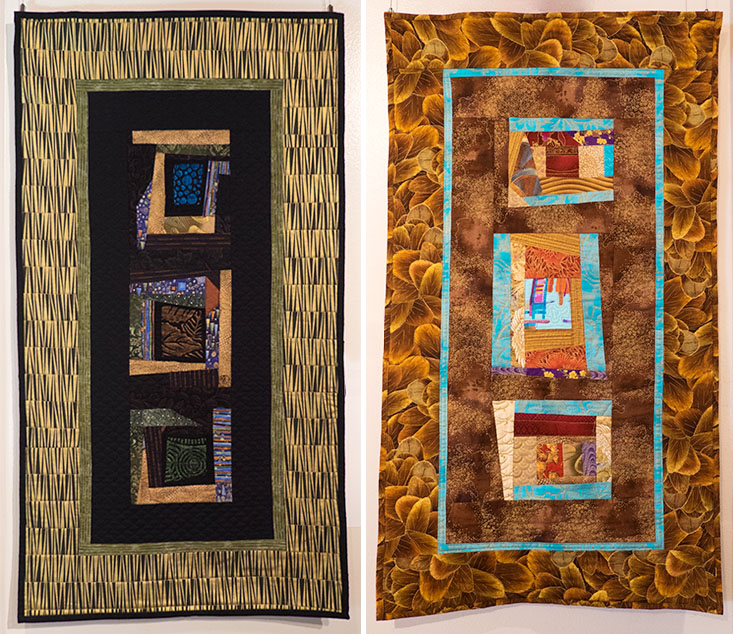
“Surface Impressions” and “Hidden Treasures” by Anne Smyers (inspired by Gwen Marston’s Liberated Quiliting style)
At first I did a little bit of a lot of things, trying out different styles and different techniques. At one point a few years down the road as I played around with some floral fabrics in my studio I created a juxtaposition of flowers that reminded me of a landscape. That was an “ah-ha!” moment for me, I felt somehow that this particular composition was an authentic expression of my aesthetic sensibility, and the floral landscape series was born.
Now I feel I’m moving into a different phase with it, where the flowers are serving the content of the piece more than just creating a pleasing arrangement. I’m currently working on a series inspired by meaningful places in my life that I have loved. I’m still using the flowers as a major motif, but in a different way.
MR: Please tell us a bit about your materials and process.
AS: I use primarily 100% quilting cottons, which are commercially sold fabrics, with the occasional hand-dyed cotton, silk or home decor fabric thrown in. A few of my pieces are beaded or otherwise embellished, as well.
I cut around the motifs or designs – usually flowers – that I want to use, and play with the arrangement of all the cut pieces on the design wall. The design wall is a flannel-covered wall in my studio to which the cut fabrics adhere and can be moved around and experimented with until the composition is right. It enables me to view what I’m doing on a vertical surface, and to get some distance from it. Once I decide on a final composition, I fuse the cut pieces to a background fabric using heat sensitive fusible webbing ironed onto the back of each cut piece.
Once it’s all fused down, the finished piece becomes the topmost layer of a quilt sandwich with batting in the middle and a backing fabric, and then it’s time to quilt. That’s the part where the three layers are fastened together with stitching, done on my home machine. Once it’s quilted the piece is squared up and bound with a fabric binding around the edge to finish all the raw edges.
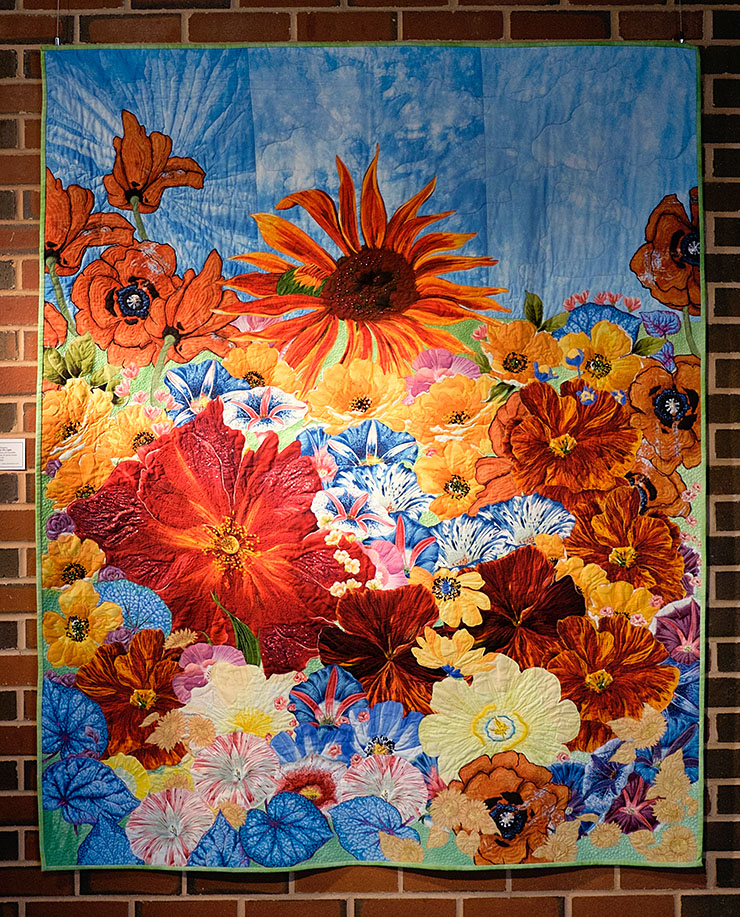
“Opening to the Light” by Anne Smyers (cotton fabrics, Shiva oil Paintstiks, Angelina fibers, glass and plastic beads)
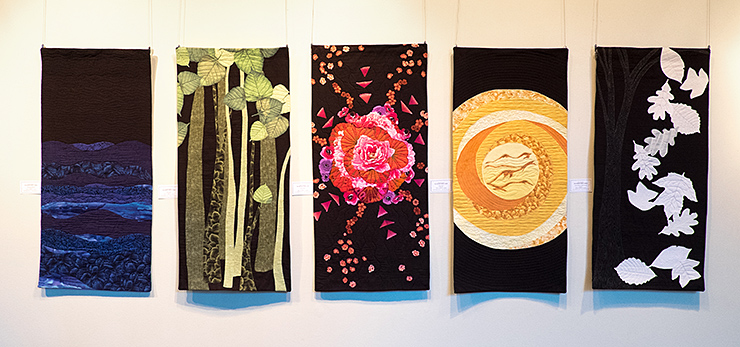
“Five Element Study: Water, Wood, Fire, Earth, and Metal” by Anne Smyers
MR: Is there anything you want to communicate to viewers through your art?
AS: The floral landscapes suggest to me that reality is more nuanced, more beautiful and marvelous than we may notice as we go about our daily business. I hope that viewers are encouraged to look carefully and closely not only at my work but at the world, and their worlds, to find the subtle layers of meaning and beauty there.
One reason I love working with flowers is that in nature they are the utmost expression of the plant’s opening to the light; the fullest, most mature stage of growth before the plant goes to seed. I love that metaphor as it relates to life in general: that we are our best selves when we allow ourselves to be open and receptive.
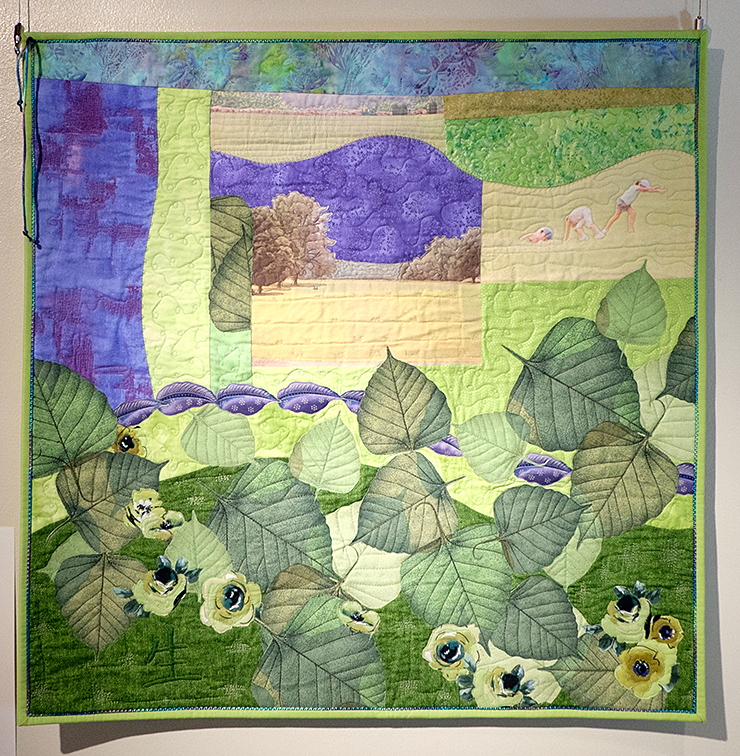
“Halcyon Days” by Anne Smyers (cotton fabrics, inkjet photo transfer, satin cording)
MR: What are you working on next?
AS: I’m working on a series called “Sense of Place,” which will represent specific locations that are meaningful to me. First in this series is “Halcyon Days,” which shows a scene from Bennington College, where I spent many summers at Tai Chi training. It’s a wonderful place.
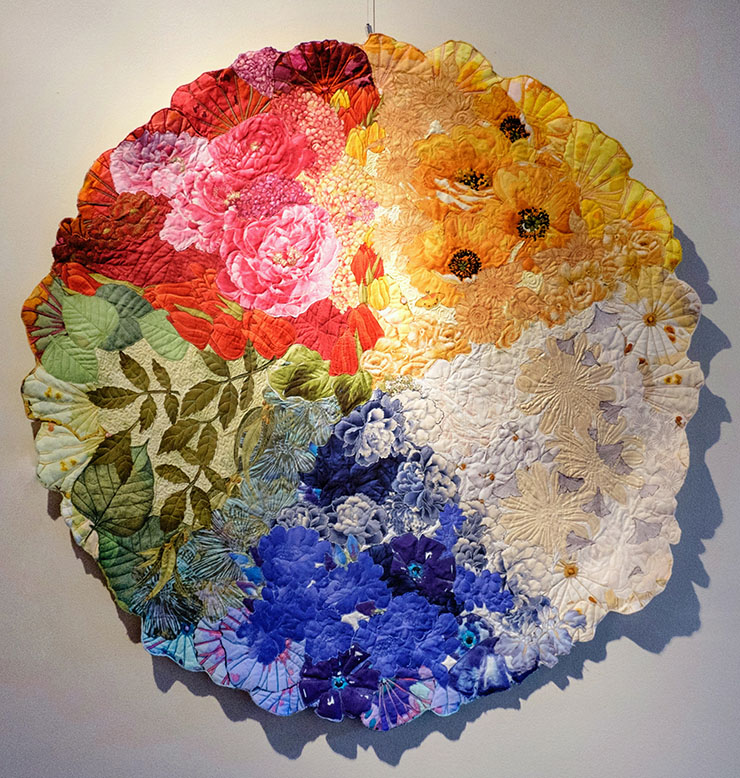
“The Five Elements in Flowers: It All Starts in the Water” by Anne Smyers (cotton and silk fabrics, Shiva oil Paintstiks)
How can people get started in the art of quilting? Can you recommend some local resources for people in the Northern Virginia area?
Here are the names of some local shops that teach workshops:
The Quilters Studio in Fairfax
Artistic Artifacts in Alexandria
Jinny Beyer Studio in Great Falls
And here’s a wonderful shop (but no classes):
Webfabrics in Purcellville
Many thanks to Anne Smyers for this look into her extraordinary quilted art!
Her solo exhibit, “The Color of Life,” will be on display until October 31, 2015 at the Reston Community Center at Hunters Woods. Admission is free. You can see more of her work at her website: AnneSmyers.com or her Etsy shop: AnneSmyersDesigns.
You can also find Anne Smyers through her House to Home One-Day Decorating business, where she helps people redecorate or reorganize their homes, using what they already own.”Home is really important to me; I recharge myself there. I think it’s really important to have a home that you love. I help people use what they already have to make their homes more comfortable and beautiful. This is redecorating without replacing everything, it’s finding fresh ways to use what you own so that you love the space you’re in.”
Related stories:
Ten Fun Facts About Patrick Dougherty’s Monumental New Sculpture at Reston Town Center
The Contemporary Jewelry of Reston’s Modern Nature Studio
At the Reston Market: The Luxurious Garments of the Alpaca Girl
At the Reston Market: Painter Rayhart
At the Reston Market: Painter Mina Karimi
A Reston Aerial Photographer Whose Technology is Half of His Art

